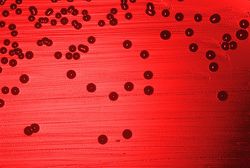Difference between revisions of "Haemophilus influenzae"
Jump to navigation
Jump to search
| Line 1: | Line 1: | ||
{{review}} | {{review}} | ||
| + | |||
| + | {{Taxobox | ||
| + | |name =''Haemophilus influenzae'' | ||
| + | |phylum =Proteobacteria | ||
| + | |class =Gamma Proteobacteria | ||
| + | |order =Pasteurellales | ||
| + | |family =Pasteurellaceae | ||
| + | |genus =Haemophilus | ||
| + | |species =''H.influenzae'' | ||
| + | }} | ||
{| cellpadding="10" cellspacing="0" border="1" | {| cellpadding="10" cellspacing="0" border="1" | ||
| Line 7: | Line 17: | ||
|} | |} | ||
| − | [[File:haemophilus in.jpg|right|thumb|250px|<small><center> Haemophilus influenzae bacteria cultured on a blood agar plate. (MarcoTolo 2006, Wikimedia commons)</center></small>]] | + | [[File:haemophilus in.jpg|right|thumb|250px|<small><center> ''Haemophilus influenzae'' bacteria cultured on a blood agar plate. (MarcoTolo 2006, Wikimedia commons)</center></small>]] |
Revision as of 10:03, 29 July 2010
| This article has been peer reviewed but is awaiting expert review. If you would like to help with this, please see more information about expert reviewing. |
| Haemophilus influenzae | |
|---|---|
| Phylum | Proteobacteria |
| Class | Gamma Proteobacteria |
| Order | Pasteurellales |
| Family | Pasteurellaceae |
| Genus | Haemophilus |
| Species | H.influenzae |
| Also known as: | Bacillus influenzae |
Haemophilus influenzae is a species of the Haemophilus genus. There are unencapsulated and encapsulated strains. Encapsulated strains can be classified by their capsular antigens. There are six types of encapsulated Haemophilus influenzae; a, b, c, d, e, and f.
Most strains of H.influenzae are opportunistic pathogens. Haemophilus influenzae can cause; Human meningitis, septicaemia, bronchopneumonia, conjunctivitis, epiglottitis, and otitis
References
Ryan KJ; Ray CG (editors) (2004). Sherris Medical Microbiology (4th ed.). McGraw Hill.
